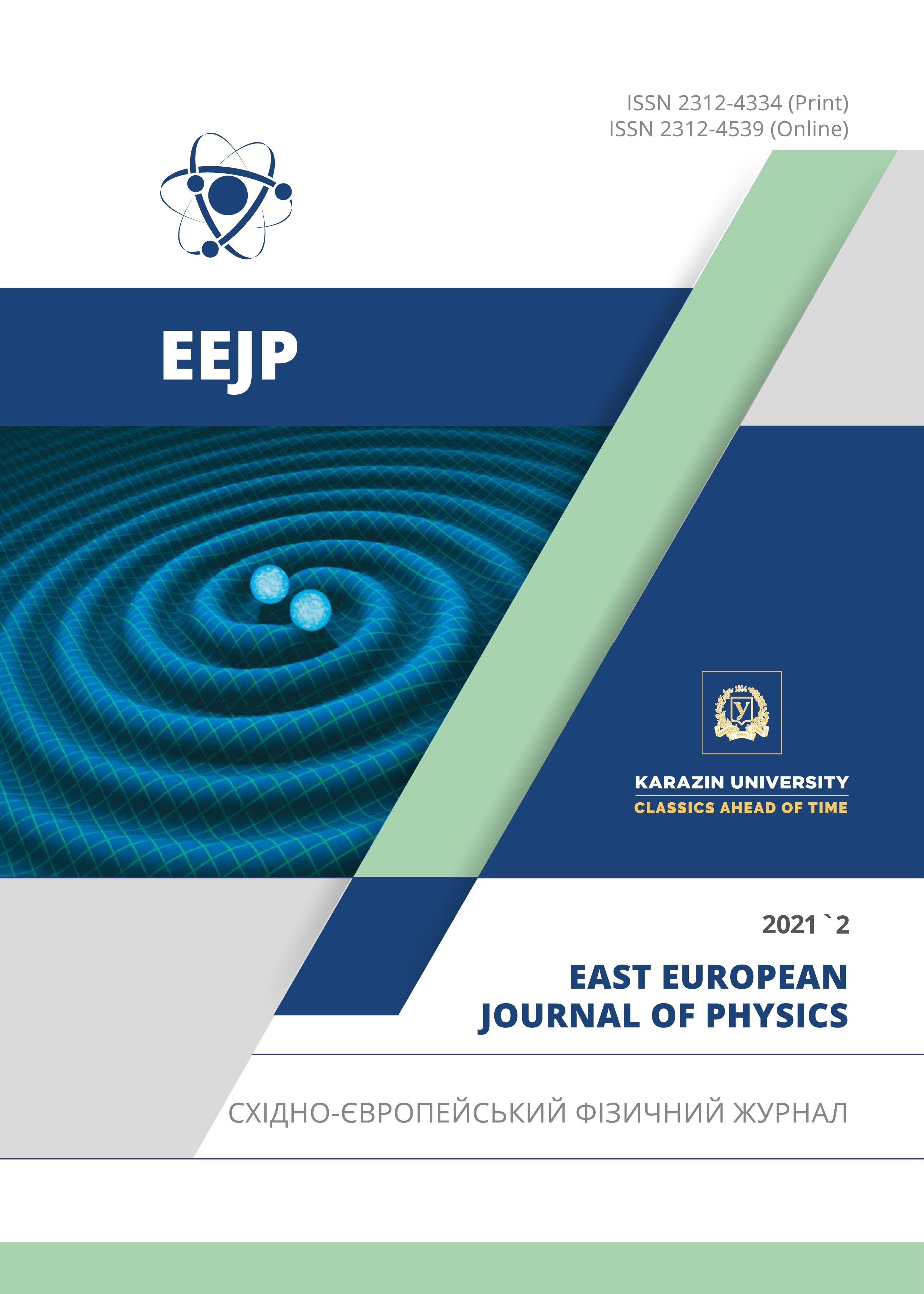Гофри з конверсією мод для резонаторів гіротронів на другій циклотронній гармоніці із поліпшеними робочими характеристиками
Анотація
Досліджено новий метод поліпшення селекції мод в резонаторах суб-терагерцових гіротронів, які працюють на другій гармоніці циклотронної частоти. Як приклад розглянуто гіротрон на другій циклотронній гармоніці з частотою 0.3 ТГц. Гіротрон розробляється для застосування в системі діагностики термоядерної плазми на основі колективного Томсонівського розсіювання (CTS) та характеризується обмеженою потужністю внаслідок конкуренції робочої ТЕ13,2 моди з модами на першій циклотронній гармоніці. Для пригамування конкуруючих мод на першій гармоніці в резонаторі гіротрона застосовані періодичні поздовжні гофри, що викликають зв'язок нормальних базисних мод, відомих як азимутальні гармоніки Блоха. Глибина цих гофрів була обрана близькою до половини та чверті довжини хвилі для робочої моди гіротрона та конкуруючих мод на першій циклотронній гармоніці, відповідно. За такої умови поздовжні гофри на стінці резонатора мають, як правило, лише неістотний вплив на робочу моду, але разом із тим можуть призводити до сильної конверсії конкуруючих мод у гармоніки Блоха високого порядку. Строгий метод зв'язаних азимутальних гармонік застосовано для дослідження впливу розмірів гофрованого резонатора на власні значення, омічні втрати та коефіцієнти зв'язку з пучком для робочої ТЕ13,2 моди та найбільш небезпечних конкуруючих мод. За допомогою самоузгодженої теорії взаємодії пучка з робочою та конкуруючими модами визначені найбільш оптимальні параметри резонатора гіротрона із поздовжніми гофрами, які забезпечують найширший діапазон одномодової роботи 0.3-ТГц гіротрона на другій циклотронній гармоніці. Показано, що в даному діапазоні вихідна потужність гіротрона може бути збільшена зі 100 кВт до 180 кВт, як того потребує CTS діагностика плазми. Виявлено, що модова чистота на виході із резонатора 0.3-ТГц гіротрона на другій циклотронній гармоніці погіршується через гофрування резонатора, яке призводить до небажаного зв'язку робочої моди ТЕ13,2 із сусідніми гармоніками Блоха у вихідний секції резонатора гіротрона.
Завантаження
Посилання
R.J. Temkin, Int. J. Terahertz Sci. Technol. 7(1), 1-9 (2014), https://doi.org/10.11906/TST.001-009.2014.03.01.
M.Y. Glyavin, T. Idehara, and S.P. Sabchevski, IEEE Trans. Terahertz Sci. Technol. 5(5), 788-797 (2015), https://doi.org/10.1109/TTHZ.2015.2442836.
M. Blank, P. Borchard, S. Cauffman, K. Felch, M. Rosay, and L. Tometich, Int. J. Terahertz Sci. Technol. 7(4), 177-186 (2016), https://doi.org/10.11906/TST.177-186.2016.12.17.
M. Thumm, J. Infrared Millim. Terahertz Waves 41(1), 1-140 (2020), https://doi.org/10.1007/s10762-019-00631-y.
T. Notake, T. Saito, Y. Tatematsu, A. Fujii, S. Ogasawara, L. Agusu, I. Ogawa, T. Idehara, and V.N. Manuilov, Phys. Rev. Lett. 103(22), 225002 (2009), https://doi.org/10.1103/PhysRevLett.103.225002.
T. Saito, N. Yamada, S. Ikeuti, S. Ogasawara, Y. Tatematsu, R. Ikeda, I. Ogawa, T. Idehara, V.N. Manuilov, T. Shimozuma, S. Kubo, M. Nishiura, K. Tanaka, and K. Kawahata, Phys. Plasmas 19(6), 063106 (2012), https://doi.org/10.1063/1.4729316.
T. Saito, S. Tanaka, R. Shinbayashi, Y. Tatematsu, Y. Yamaguchi, M. Fukunari, S. Kubo, T. Shimozuma, K. Tanaka, and M. Nishiura, Plasma Fusion Res. 14, 1406104 (2019), https://doi.org/10.1585/pfr.14.1406104.
K.A. Avramides, C.T. Iatrou, and J.L. Vomvoridis, IEEE Trans. Plasma Sci. 32(3), 917-928 (2004), https://doi.org/10.1109/TPS.2004.828781.
K.A. Avramides, J.L. Vomvoridis, and C.T. Iatrou, in: AIP Conference Proceedings 807, 264-270 (2006), https://doi.org/10.1063/1.2158787.
V.I. Shcherbinin, V.I. Tkachenko, K.A. Avramidis, and J. Jelonnek, IEEE Trans. Electron Devices 66(12), 5313-5320 (2019), https://doi.org/10.1109/TED.2019.2944647.
V.I. Shcherbinin, Y.K. Moskvitina, K.A. Avramidis and J. Jelonnek, IEEE Trans. Electron Devices 67(7), 2933-2939 (2020), https://doi.org/10.1109/TED.2020.2996179.
V.I. Shcherbinin, K.A. Avramidis, M. Thumm and J. Jelonnek, J. Infrared Millim. Terahertz Waves 42(1), 93-105 (2021), https://doi.org/10.1007/s10762-020-00760-9.
T.I. Tkachova, V.I. Shcherbinin, and V.I. Tkachenko, J. Infrared Millim. Terahertz Waves 40(10), 1021-1034 (2019), https://doi.org/10.1007/s10762-019-00623-y.
T.I. Tkachova, V.I. Shcherbinin, V.I. Tkachenko, Z.C. Ioannidis, M. Thumm, and J. Jelonnek, J. Infrared Millim. Terahertz Waves 42(3), 260-274 (2021), https://doi.org/10.1007/s10762-021-00772-z.
J.B. Davies, Proc. IEE-Part C 109(15), 162-171 (1962), https://doi.org/10.1049/pi-c.1962.0022.
T. Scharten, J. Nellen, and F. van den Bogaart, Proc. IEE-Part H 128(3), 117-123 (1981), https://doi.org/10.1049/ip-h-1.1981.0019.
C.T. Iatrou, S. Kern, and A.B. Pavelyev, IEEE Trans. Microw. Theory Techn. 44(1), 56-64 (1996), https://doi.org/10.1109/22.481385.
V.I. Shcherbinin, and V.I. Tkachenko, J. Infrared Millim. Terahertz Waves 38(7), 838-852 (2017), https://doi.org/10.1007/s10762-017-0386-x.
V.I. Shcherbinin, B.A. Kochetov, A.V. Hlushchenko, and V.I. Tkachenko, IEEE Trans. Microw. Theory Techn. 67(2), 577-583 (2019), https://doi.org/10.1109/TMTT.2018.2882493.
T.I. Tkachova, V.I. Shcherbinin, and V.I. Tkachenko, in: Proc. Int. Conf. Math. Methods Electromagn. Theory (MMET’2018) (Kyiv, Ukraine, 2018), pp. 238-241, https://doi.org/10.1109/MMET.2018.8460433.
T.I. Tkachova, V.I. Shcherbinin, and V.I. Tkachenko, Problems Atomic Sci. Technol. 6(118), 67-70 (2018), http://dspace.nbuv.gov.ua/handle/123456789/148829.
T.I. Tkachova, V.I. Shcherbinin, and V.I. Tkachenko, Problems Atomic Sci. Technol. 4(122), 31-34 (2019).
V.I. Shcherbinin, A.V. Hlushchenko, A.V. Maksimenko, and V.I. Tkachenko, IEEE Trans. Electron Devices 64(9), 3898-3903 (2017), https://doi.org/10.1109/TED.2017.2730252.
Авторське право (c) 2021 Tetiana Tkachova, Vitalii Shcherbinin, Viktor Tkachenko

Цю роботу ліцензовано за Міжнародня ліцензія Creative Commons Attribution 4.0.
Автори, які публікуються у цьому журналі, погоджуються з наступними умовами:
- Автори залишають за собою право на авторство своєї роботи та передають журналу право першої публікації цієї роботи на умовах ліцензії Creative Commons Attribution License, котра дозволяє іншим особам вільно розповсюджувати опубліковану роботу з обов'язковим посиланням на авторів оригінальної роботи та першу публікацію роботи у цьому журналі.
- Автори мають право укладати самостійні додаткові угоди щодо неексклюзивного розповсюдження роботи у тому вигляді, в якому вона була опублікована цим журналом (наприклад, розміщувати роботу в електронному сховищі установи або публікувати у складі монографії), за умови збереження посилання на першу публікацію роботи у цьому журналі.
- Політика журналу дозволяє і заохочує розміщення авторами в мережі Інтернет (наприклад, у сховищах установ або на особистих веб-сайтах) рукопису роботи, як до подання цього рукопису до редакції, так і під час його редакційного опрацювання, оскільки це сприяє виникненню продуктивної наукової дискусії та позитивно позначається на оперативності та динаміці цитування опублікованої роботи (див. The Effect of Open Access).








